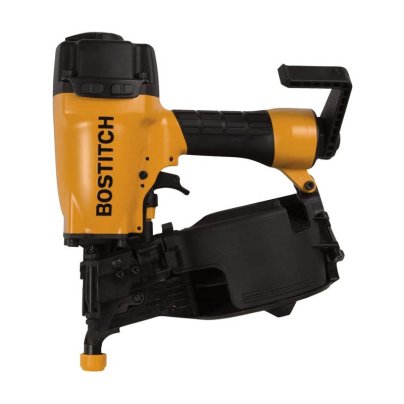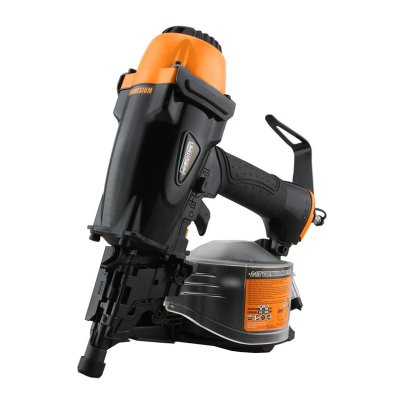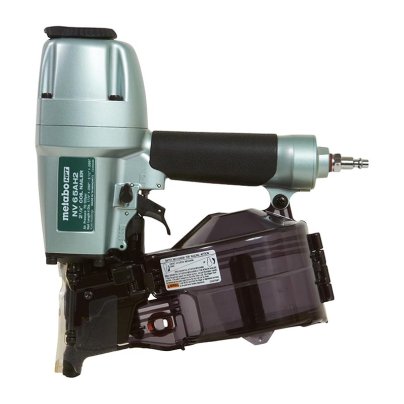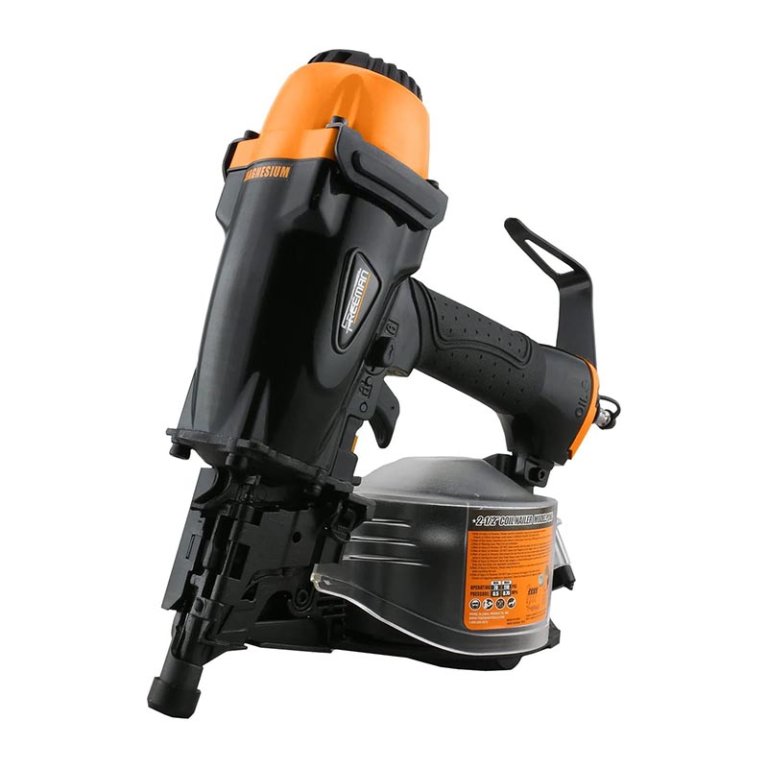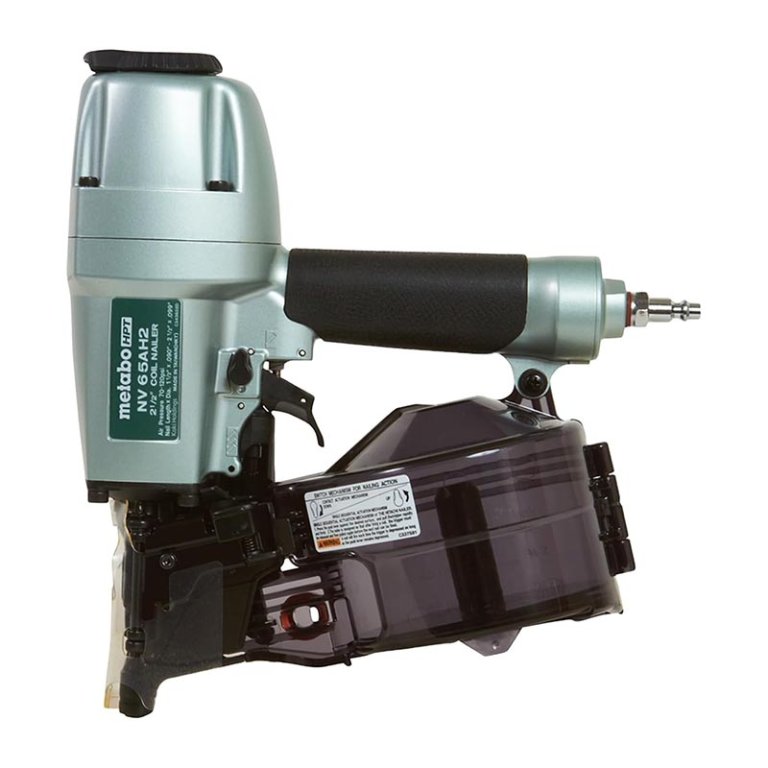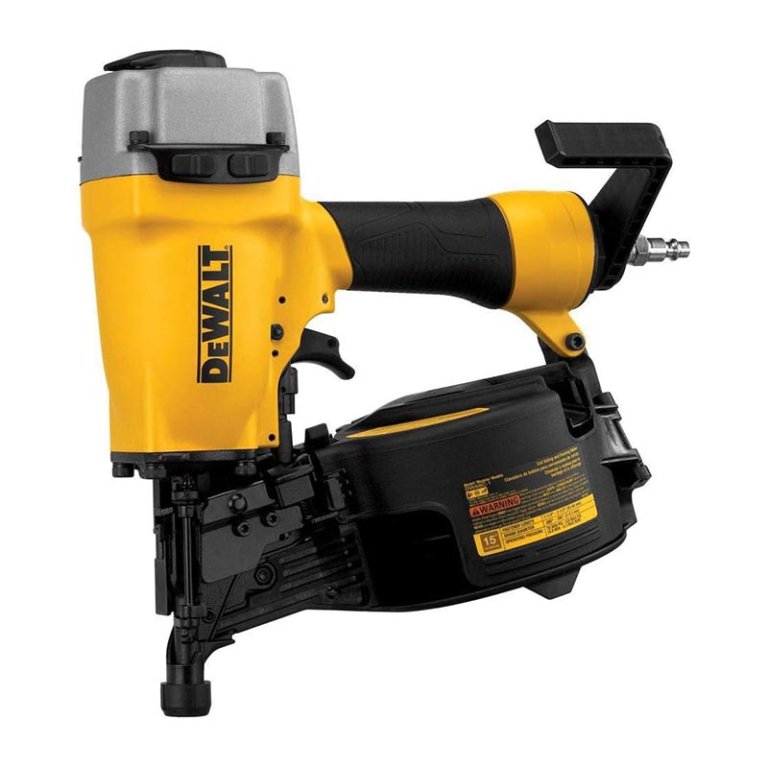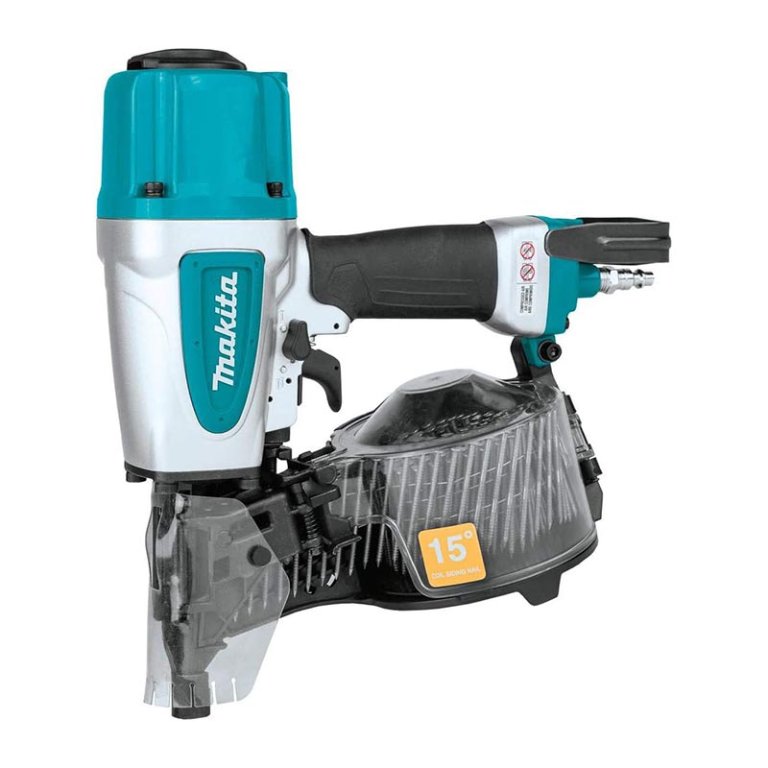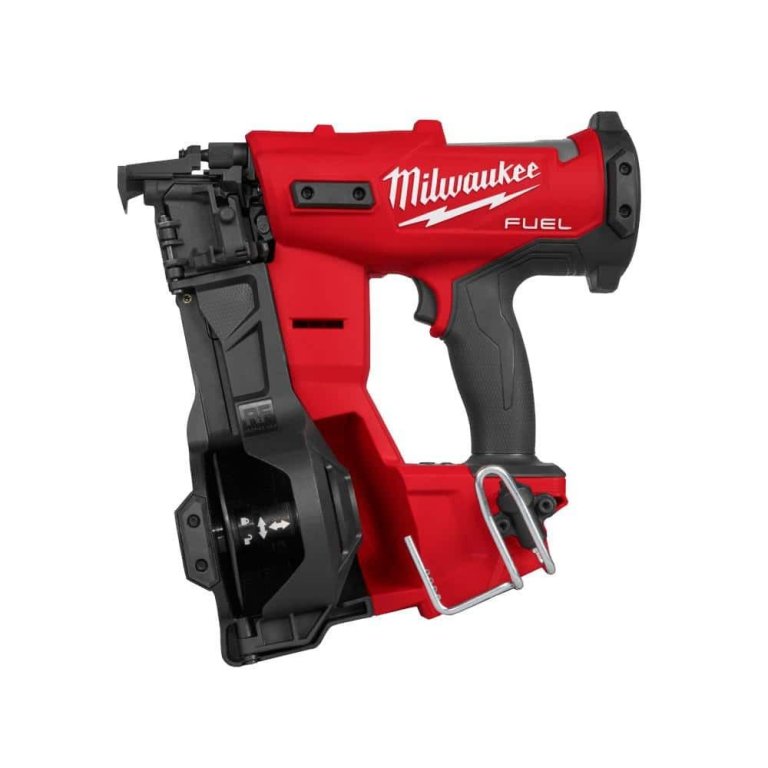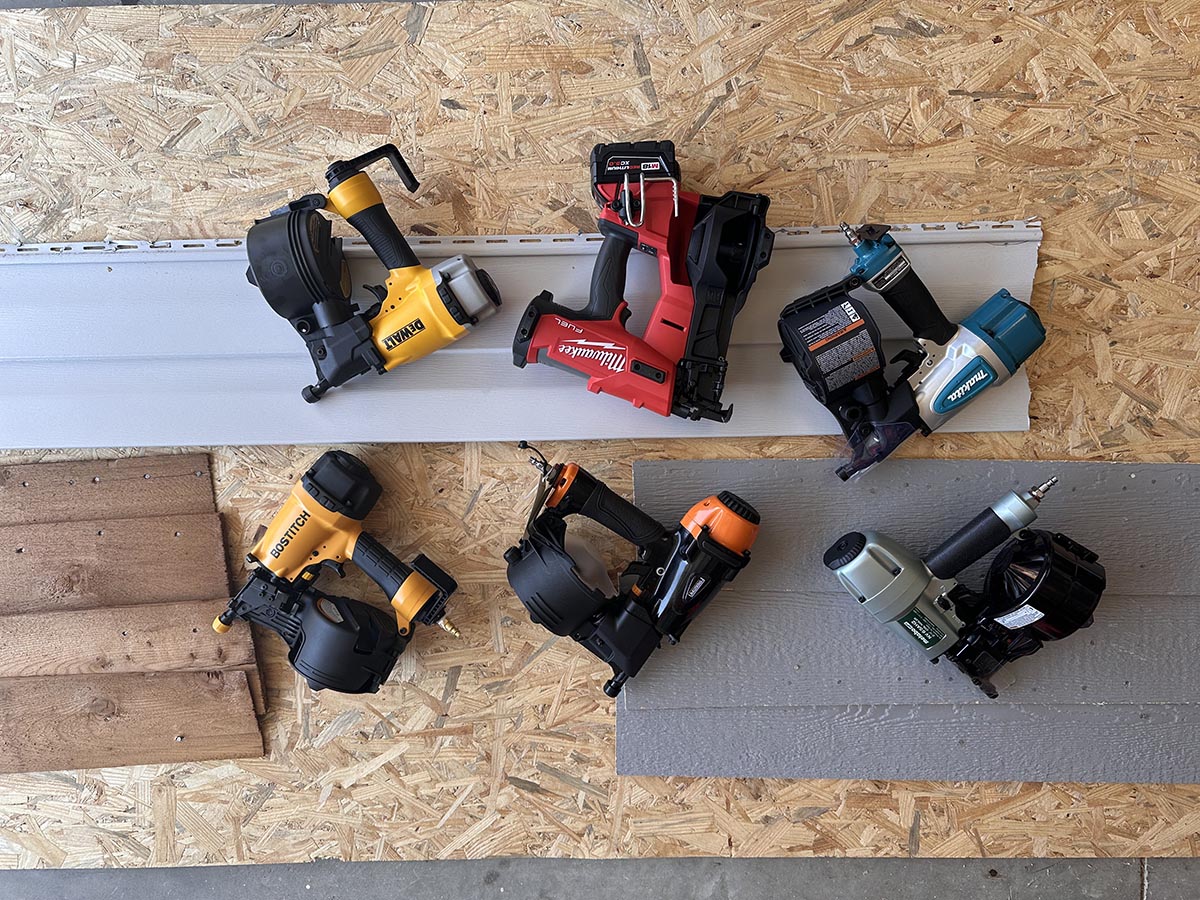
We may earn revenue from the products available on this page and participate in affiliate programs. Learn More ›
You can install siding the old-fashioned way using a traditional hammer, or you can up your game and save your shoulder by investing in a siding nailer. This tool inserts each nail to the same depth with a single blow, so the siding is properly secured.
Nailers come in both pneumatic varieties that work with an air compressor and hose and cordless varieties. A siding nail gun can fire nails up to 2½ inches long and has depth adjusters that allow you to dial in the perfect nail driving power for whatever material you’re working with. We selected six top siding nailers, then put them to the test, using them to secure vinyl, cement board, and cedar plank siding. We found the Bostich Coil Siding Nailer, with its lightweight design, reliable nailing performance, and ability to handle a wide range of nail lengths, to be the best option.
This guide will clarify the differences between types of nail guns and help you find the best siding nailer for your projects.
- BEST OVERALL: Bostitch 1¼-to-2½-Inch Coil Siding Nailer
↓ Jump to Review - BEST BANG FOR THE BUCK: Freeman Pneumatic 2½-Inch Coil Siding Nailer
↓ Jump to Review - BEST UPGRADE: Metabo HPT 2½-Inch Coil Siding Nailer
↓ Jump to Review - BEST NAILING POWER: DeWalt 15-Degree Coil Siding and Fencing Nailer
↓ Jump to Review - BEST EASY TO USE: Makita Pneumatic 2½-Inch 15-Degree Siding Coil Nailer
↓ Jump to Review - BEST CORDLESS: Milwaukee M18 FUEL Coil Roofing Nailer
↓ Jump to Review

Before You Buy a Siding Nailer
There are a wide variety of nailers (or nail guns) available to fulfill different tasks. They range from compact brad nailers for detailed work to heavy-duty framing nailers, some of which are capable of driving nails over 6 inches long.
A nailer for siding is a very function-specific tool. The best siding nailer will help you complete the task quickly, but first, think about the project for which you are using it. If you have a lot of siding to fit, a siding coil nailer is what you need, but if you only have modest repair work to do—and you’re torn between a siding nailer and a framing nailer—then a midsize version of the latter should be capable of doing the job.
Siding Nailers Comparison
| Product | Nail length | Magazine capacity | Weight |
| Bostitch 1¼-to-2½-Inch Coil Siding Nailer | 1¼ to 2½ inches | 300 nails | 5.1 pounds |
| Freeman Pneumatic 2½-Inch Coil Siding Nailer | 1¼ to 2½ inches | 400 nails | 6.6 pounds |
| Metabo HPT 2½-Inch Coil Siding Nailer | 1½ to 2½ inches | 200 to 300 nails | 4.8 pounds |
| DeWalt 15-Degree Coil Siding and Fencing Nailer | 1¾ to 2½ inches | 300 nails | 5.1 pounds |
| Makita Pneumatic 2½-Inch 15-Degree Siding Coil Nailer | 1¼ to 2½ inches | N/A | 5.1 pounds |
| Milwaukee M18 FUEL Coil Roofing Nailer | ¾ to 1¾ inches | 120 nails | 7.5 pounds |
Our Top Picks
The following list was collated with a combination of personal experience and market research. It factors in manufacturer reputation, durability, features, and cost. The best siding nailer in each category has been chosen to help you focus on the right tool for your specific needs.
Best Overall
Photo: AmazonWhat We Like
- Takes a broad range of nail sizes
- Lightweight design makes it easy to use
- Great sightlines with narrow compact body
- Precise nail depth adjuster
What We Don’t Like
- Must switch out trigger to switch to bump mode
Specs
- Nail length 1¼ to 2½ inches
- Magazine capacity 300 nails
- Weight 5.1 pounds
Our Ratings
| Ease of Use | 4.8/5 | Performance | 4.9/5 | Durability | 5/5 | Value | 4.2/5 |
This Bostitch coil siding nailer checks all the boxes when it comes to what you want out of a cordless siding nailer. It performed flawlessly during testing, firing nails into denser cedar and cement siding consistently, with no jamming even when loaded with longer 2½-inch nails. At just 5.1 pounds, the Bostich nailer is easy to wield, while also being more compact than most of the nailers we tested. This gave it a well-balanced feel when using it, while also giving us a great line of sight, something we appreciated when lining up nails with the tabs on vinyl siding.
The depth adjuster is a little more difficult to turn than we’d like, but it makes precise adjustments to depth. After setting the depth to a high setting for cedar siding, we were able to back it down for vinyl siding. We also liked the rubber bumpers on the sides that prevent it from sliding if you’re working on a sloped surface, such as a roof. The Bostitch does convert to sequential firing, but you’ll need to change out the trigger to do so.
What our tester says: “Bostitch’s nailer is everything you want out of a pneumatic nailer. It’s lightweight, powerful, holds a broad range of nail sizes, and doesn’t jam easily.”—Tony Carrick, Product Reviews tester and writer
Get the Bostitch siding nailer at Amazon, Walmart, or Acme Tools.
Best Bang for the Buck
Freeman Pneumatic 2½-Inch Coil Siding Nailer
Buy at AmazonWhat We Like
- Reliable firepower at an affordable price
- Rugged build quality
- Easy-to-use toolless depth adjuster
- Takes a broad range of nails
What We Don’t Like
- Weighs an arm-burning 6.6 pounds empty
Specs
- Nail length 1¼ to 2½ inches
- Magazine capacity 200 to 400 nails
- Weight 6.6 pounds
Our Ratings
| Ease of Use | 4/5 | Performance | 4.5/5 | Durability | 4.5/5 | Value | 4.5/5 |
Freeman tools are recognized for their combination of durability and value. Despite the low cost of the Freeman siding nailer, it offers a feature set that rivals those of more expensive competitors. During testing, it performed similarly to our top nailers, driving in nails at uniform depths reliably, whether we were nailing vinyl siding or cement board siding. We also appreciated its large, bright orange adjust knob, which we found easier to turn than the tight adjusters on other pneumatic nail guns we tested. We found ourselves making on-the-fly depth adjustments mid nail with a single finger. While some users state the Freeman can be prone to jams and double-firing, we didn’t experience any issues as long as the magazine is properly adjusted to match the nail size.
The Freeman nailer does require some strength to use, as it weighs an arm-burning 6.6 lbs. empty. That said, it’s a durably built nailer with a heavy-duty aluminum and steel body. The Freeman also has some other thoughtful features, including an adjustable air vent and rubber bumpers on the side that prevent it from sliding off a roof.
Get the Freeman siding nailer at Amazon.
Best Upgrade
Photo: AmazonWhat We Like
- Lightweight design makes it easy to hold
- Can switch between bump and sequential without changing trigger
- Magazine design makes it easy to load nails
What We Don’t Like
- One of the priciest pneumatic nailers
Specs
- Nail length 1½ to 2½ inches
- Magazine capacity 200 to 300 nails
- Weight 4.8 pounds
Our Ratings
| Ease of Use | 4.6/5 | Performance | 5/5 | Durability | 4/5 | Value | 4.8/5 |
Metabo routinely ranks at or near the top of the heap when it comes to nailers, and its siding nailer is no exception. A compact design, features that just make it easier to use, and a rock-solid build quality make this nailer worthy of a professional job site.
It produced excellent power during testing, driving in nails at a reliable depth. Metabo’s siding nailer is also relatively streamlined, giving us a better line of sight than some of the more bulbous nailers we tested. Adjusting depth was relatively easy, either by using the toolless depth adjuster knob or by changing the pressure output on our pancake air compressor.
The Metabo siding nailer is also the lightest we tested, weighing just under 5 pounds empty. Given that siding installation jobs are large projects, the lighter weight makes a big difference. Loading coils of nails is easy thanks to a magazine that tilts outward when you open it to receive them. We also like the rotatable air deflector that allows us to direct the air exhaust away from our faces. If we do have a complaint, it’s that the depth adjuster knob is a little tough to turn.
It also has a die-cast aluminum body and steel head that makes it capable of taking a beating, which is perfect for the pro jobsite. The Metabo comes with a steep price tag, but it’s worth the investment if you have multiple siding installation projects lined up.
What our tester says: “It’s pricier than other nailers, but the power, extra controls, and build quality of this nailer make it worth it if you need a nailer you can use day in and day out.”—Tony Carrick, Product Reviews tester and writer
Get the Metabo siding nailer at Amazon or Lowe’s.
Best Nailing Power
Photo: AmazonWhat We Like
- Tremendous nail-driving power
- Easy to access depth adjuster
- Rock-solid build quality
What We Don’t Like
- Have to change out trigger to switch from sequential to bump modes
Specs
- Nail length 1¾ to 2½ inches
- Magazine capacity 300 nails
- Weight 4.9 pounds
Our Ratings
| Ease of Use | 4.5/5 | Performance | 4.7/5 | Durability | 5/5 | Value | 4.2/5 |
DeWalt’s pneumatic nailer is a well-built tool with the ability to handle a broad range of nail sizes while boasting some pretty impressive power. It drove nails easily into cedar planks, even burying the head deep into the wood with longer 2½-inch nails. It performed expertly on cement board siding, driving in nails just below the surface every time with no misfires. It’s not all about power, though. We were able to dial that power back using the depth adjuster to handle vinyl siding.
Its depth adjuster is easy to access and allowed us to back off the power to get that just right nail depth. DeWalt’s coil nailer is also easy on the arm, thanks to an empty weight of just under 5 pounds, making it one of the lightest coil siding nailers we tested. It comes with both sequential and bump firing modes, though you’ll have to go through the process of trading out the trigger to switch modes.
We expect durability out of the DeWalt name, and this nailer is no exception. It’s built like a rock with a heavy-duty aluminum housing and rubber bumpers on the sides that protect the housing and prevent it from sliding when you set it down on the roof.
Get the DeWalt coil siding and fencing nailer at Amazon or The Home Depot.
Best Easy to Use
Photo: AmazonWhat We Like
- Well-designed controls make it easy to use
- Consistent nail-firing power
- Easy to adjust nail depth
- Easy access switch for firing modes
What We Don’t Like
- Pricier than other pneumatic siding nailers
Specs
- Nail length 1¼ to 2½ inches
- Magazine capacity 300 nails
- Weight 5.1 pounds
Our Ratings
| Ease of Use | 4.6/5 | Performance | 4.5/5 | Durability | 5/5 | Value | 5/5 |
We laud Makita’s tools for their well-designed controls, and this nailer is a great example of what the brand brings.
Being lightweight, coupled with a compact head, made it feel nimble in the hand while giving us a clear line of sight. The depth control has nine detents, which makes adjustments feel more precise, and the switch for bump and sequential modes is within thumb’s reach, making it easy to change on the fly. At 5.1 pounds, it’s also one of the lightest nailers we tested.
All of this adds up to a nailer capable of handling a broad range of jobs. We had no problem driving longer nails into our cement board siding and through our wall sheathing. We were then able to dial back the power to attach vinyl siding without burying the head or cracking the vinyl tabs.
Along with being powerful, it’s also well built. The casing is made from steel and aluminum alloy. Rubber bumpers on the sides keep the nailer from sliding when you set it down on uneven surfaces. While we expect high quality from Makita, the brand’s tools typically come at a premium price. That’s not the case with this nailer, which is one of the more reasonably priced models on our list.
Get the Makita pneumatic nailer at Amazon or The Home Depot.
Best Cordless
Milwaukee M18 Fuel Coil Roofing Nailer
Buy at The Home DepotWhat We Like
- Excellent nail driving power
- Can fire more than 1,000 nails on a single charge
- Quickly switches between bump and sequential modes
What We Don’t Like
- Much heavier than a pneumatic nailer
- Limited to shorter nails
Specs
- Nail length ¾ to 1¾ inches
- Magazine capacity 120 nails
- Weight 7.3 pounds
Our Ratings
| Ease of Use | 5/5 | Performance | 5/5 | Durability | 5/5 | Value | 5/5 |
Milwaukee’s cordless roofing nailer frees you from the constraints of air hoses and pancake air compressors, instead relying on a motor and rechargeable battery to fire nails. It produces exceptional power, driving nails cleanly into cedar and cement board with ease, while also allowing us to dial back the power for vinyl siding via the easy-to-use depth adjuster. While we didn’t fire enough nails to test the battery life, Milwaukee says you get 1,100 shots on a single charge with an M18 Red Lithium High Output 3.0Ah battery, which is pretty high.
There’s also other notable features, including a control panel that allows you to power the nailer on or off and switch between bump mode and sequential firing. No need to trade out the trigger with this nailer. There are also replaceable bumpers on the side that prevent the tool from sliding away if you’re using it on a roof.
There are some compromises with the Milwaukee cordless nailers. Since it carries its power source with it, it weighs a hefty 7.5 pounds with no battery or nails. Fully loaded and powered up, it’s significantly heavier than the pneumatic nailers we tested. Like most cordless siding nailers, it’s limited to 1¾-inch nails.
Get the Milwaukee M18 Fuel Coil Roofing Nailer at The Home Depot.
Jump to Our Top Picks
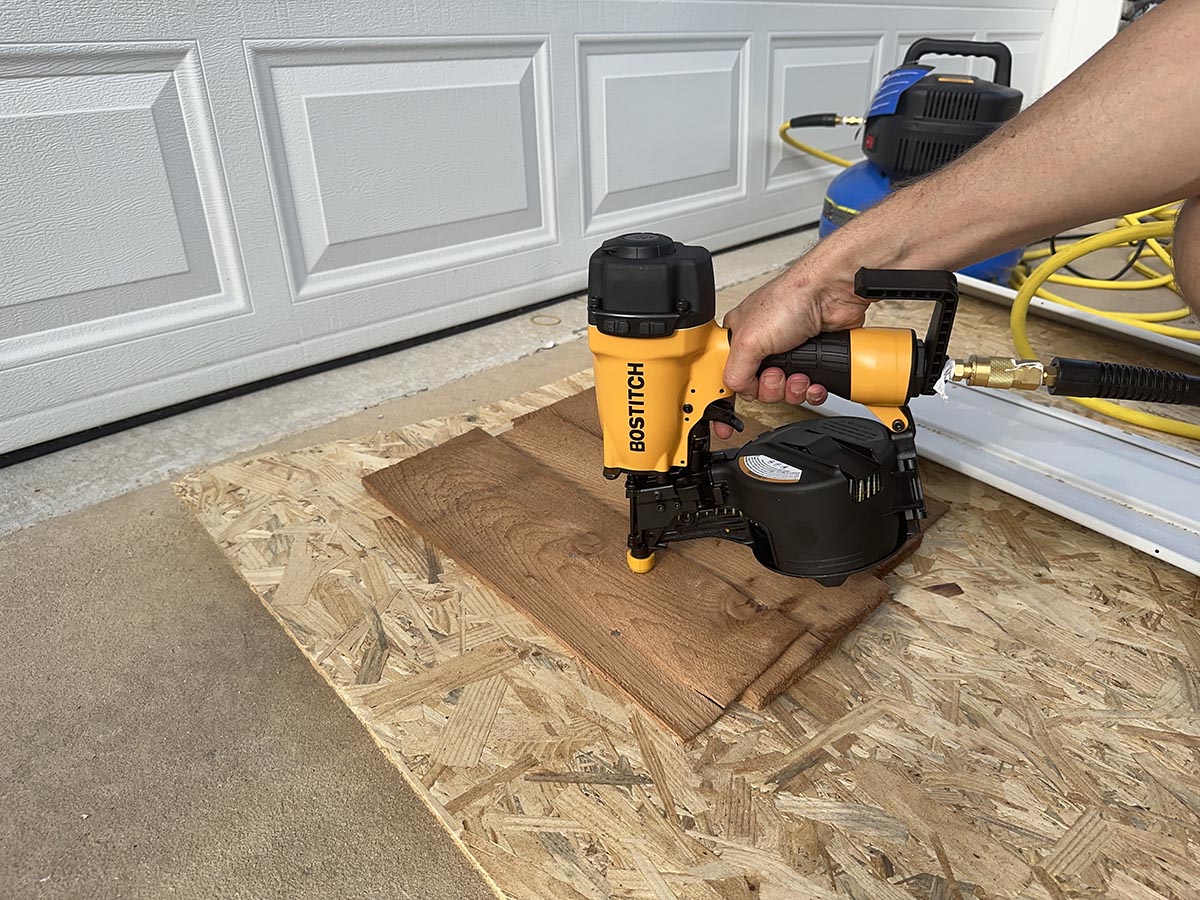
How We Tested the Best Siding Nailers
We made our initial selections based on research, comparing specs and scouring user reviews. All of our picks are from brands we know have a stellar reputation for making quality nail guns.
After making our six selections, we set about testing them. To accomplish this, we used each nailer to attach different types of siding, including vinyl, cement board, and cedar plank, to ¼-inch wall sheathing, firing no fewer than 50 nails with each nailer.
While testing, we assessed each nailer’s ability to drive nails into each material without jams or misfires. We also evaluated how well each nailer was able to adjust nail depth based on the type of material.
While using each nailer, we considered how comfortable each model was to hold based on weight and balance. Finally, we considered how easy it was to load nails and switch from sequential to bump firing modes.
| Product | Ease of Use | Performance | Durability | Value |
| Bostitch 1¼-to-2½-Inch Coil Siding Nailer | 4.8/5 | 4.9/5 | 5/5 | 4.2/5 |
| Freeman Pneumatic 2½-Inch Coil Siding Nailer | 4/5 | 4.5/5 | 4.5/5 | 4.5/5 |
| Metabo HPT 2½-Inch Coil Siding Nailer | 4.6/5 | 5/5 | 4/5 | 4.8/5 |
| DeWalt 15-Degree Coil Siding and Fencing Nailer | 4.5/5 | 4.7/5 | 5/5 | 4.2/5 |
| Makita Pneumatic 2½-Inch 15-Degree Siding Coil Nailer | 4.6/5 | 4.5/5 | 5/5 | 5/5 |
| Milwaukee M18 FUEL Coil Roofing Nailer | 4/5 | 4.5/5 | 4.5/5 | 4.2/5 |
What to Consider When Choosing a Siding Nailer
There are many different siding nailers to choose from. Some are more suited to low-volume DIY use, while others are heavy-duty professional models. When deciding on the best siding nailer for siding jobs you need to undertake, look for one that is high-quality and offers the right combination of features.
Size and Weight
Like other types of nailers, balance and weight are key features of siding nailers. If a tool is top-heavy, it will stress your wrist, which will quickly become uncomfortable. Much of the time, fitting siding necessitates being up a ladder, where a bulky tool could be difficult to control. Siding nailers aren’t particularly heavy—4½ to 6½ pounds (framing nailers can be twice that)—but a single pound can make a big difference when you’re using the tool for extended periods.
To combat both of these problems, aluminum and magnesium alloys are frequently used for things like motor housings instead of steel. This reduces weight at the top of the nailer, where it most affects handling, but doesn’t reduce durability or performance. It’s also worth checking the hand grip. A textured, rubberized handle allows for a firm, confident hold.
Nail Type and Length
The frame of the house and the siding often move slightly as seasons change, so siding nails have a round head to prevent the siding from pulling free. The shank of the nail is usually textured, either with rings or a spiral, to improve grip on the wood.
The most common material is galvanized steel. Electroplated is the more economical type, though hot-dipped galvanizing provides a thicker, more durable coating. Wood for shingles or clapboard siding that contains natural tannins will attack ordinary steel, so aluminum nails may be used instead. Stainless steel is another option, particularly in coastal areas, because it’s more resistant to the salt in the air.
Length varies from 1½ to 2½ inches, with longer nails generally being employed when a liner, backing board, or battens are positioned between frame and siding.
Nail Compatibility
Not all nails work with all nailers, so it’s important to check compatibility when purchasing nails for your siding nailer. Check the nailer angle, shank diameter, and length. Most siding nailers take 15-degree nails between 1½ inches and 2½ inches long with a shank that ranges between 0.090 and 0.99 inches in diameter. That’s not the case with all nailers, so it’s important to check the specs before purchasing nails.
Magazine Capacity
Siding nails are provided in a long coil, almost always set at a 15-degree feed angle, and are collated (held together) either by welded wire or plastic ribbon. The former is less expensive, whereas the latter provides a neater finish. This coil fits into the magazine on the nailer and feeds automatically. Some house siding nailers can use either collation type, but it’s not always the case.
Magazine capacity varies from 300 to 500 nails, depending on model and nail size. It’s tempting to think that the best framing nailer has the largest capacity. It will certainly mean the gun can be operated for longer before needing to be reloaded, but 500 nails of any size weigh significantly more than 300. That could tire the user more quickly. Most magazines are side-loading, which is fast and easy.
Power Source
Siding nailers come in both cordless and pneumatic options. For pneumatic, you’ll need an air compressor to run them. There are many different models available, and lightweight portable compressors have their advantages, but it’s important that the one you choose can supply adequate operating pressure. Generally speaking, that will be somewhere between 70 PSI and 120 PSI.
It’s also important to have a sufficiently high-pressure hose to reach from the compressor sitting on the ground to the highest point where the siding will be fitted. This usually has to be purchased separately, so it’s vital that the specification and type of fitting are checked before ordering.
A cordless siding nailer uses an electric motor and rechargeable battery for power, so they don’t require a pancake air compressor. While you won’t have to drag around a pancake air compressor and mess with an air hose with a cordless model, they’re significantly heavier and are limited by the amount of power in their battery. Most cordless nailers max out at 1¾-inch nails, while pneumatic models can fire nails up to 2½ inches long.
Firing Mode
A siding nailer can fire the nail in one of two ways: either sequential or contact (also called “bump”). Anyone who has used a siding coil nail gun of any type will have come across sequential firing, which simply means the nail is fired when the trigger is pressed.
Contact firing works with the trigger continually depressed. The mechanism is then activated as soon as the nose of the nailer is bumped against the siding material. In the hands of an experienced contractor, the technique can look very impressive, with nails being fired several times a second. However, skill is required for consistent nail positioning, and it takes time to learn. DIY users will find sequential firing much more controllable. Some siding nailers are switchable between modes.
Depth Adjustment
Having depth adjustment is important for two reasons. First, it compensates for using nails of different lengths. Second, it can alter the firing pressure to suit the wide variety of siding materials available.
Normally when you insert a nail, whether with a hammer or a nail gun, you want that nail head to be driven flush with the surface, or even slightly below. When you’re fitting siding, you need to leave a small gap to allow for the natural movement we mentioned earlier.
Wood, vinyl, concrete, etc., all have different amounts of resistance as the nail passes through. If the depth were fixed, it would be impossible to use the same gun for different materials. The best siding nailer can be adjusted to compensate.
Jam Removal
All nailers jam occasionally. With budget models, it may be that the mechanism isn’t as well-made as it might be, though faults in the nail coil or small bits of debris getting caught inside the nailer can also cause problems.
Whatever the reason, a jammed nail is frustrating at best. Being able to remove it quickly is a valuable feature. As most jams occur in or near the nose of the nailer, easy access to this area should be provided. Being able to clear a jam without needing your tool kit is a definite advantage, and good siding nailers make this possible.
Whatever method is offered, always remember to disconnect the air hose before attempting to remove a jammed nail. An accidental misfire could be extremely dangerous.
Additional Features
While the sections above cover the key elements when choosing the best siding nailer, there are several other features that add convenience.
In order to expel air after each strike, siding nailers have an exhaust. If it’s poorly directed, it puffs air straight in your face. It’s not dangerous, but it’s nice if it can be directed elsewhere.
A no-mar rubber nose (which oddly is called a “foot” on some models) helps stop the nailer from marking the surface of the siding. If you’re using wire collated nails, the gun will eject small pieces of wire debris as you work, so the facility to catch or direct these is also useful. A lock setting, which prevents accidental firing, is an added bonus, increasing safety. Several models also incorporate a useful belt hook.
Tips for Using a Siding Nailer
Siding nailers are powerful tools, but they can be dangerous, so safety is an extremely important consideration. Here are some tips that will help you stay safe and do a top-notch job.
- Always wear safety glasses, ear protection, and sturdy footwear. Gloves are also recommended. Never work when you are not 100 percent fit and focused.
- Never point a siding nailer at anyone. Ensure the work area is free of people and pets. Check for trip hazards.
- If the siding nailer jams, disconnect the air supply before attempting to free it. If a nail doesn’t fire, don’t assume the nailer is empty.
- Double-check your depth setting before you start. Ensure your compressor is providing sufficient air pressure.
- Contact firing is much faster than sequential (trigger activated), but it requires concentration and good control of the tool. If you’ve never used the feature before, practice on a few pieces of scrap wood until you’re comfortable with it.
- If using sequential firing, place the gun firmly against the siding before squeezing the trigger.
- Hold the nailer vertically so that the nail enters the siding at 90 degrees, not sloping up or down. Supporting the rear of the nailer with your free hand may help.
FAQs
The information above will undoubtedly leave you better informed about which would be the best nail gun siding tool for your project. However, it’s understandable that questions may remain. The following answers address some of the most common concerns.
You can use a framing nail to secure siding in a pinch, but it’s not recommended. Framing nailers produce too much power, even after adjusting the depth, and can damage the siding. Framing nailers also don’t work with the ring-shanked nails for siding, which are designed to hold siding material in place while also countersinking the head, making the nail heads more visible and more likely to pull out later. Finally, most framing nailers have a claw-like tip designed to dig into materials, which can damage the surface of the siding.
It’s not recommended. The maximum nail length in a siding nailer is 2½ inches, and framing usually requires a more powerful hold. Framing nailers normally use nails that are 3½ inches in length, or longer. In most cases, the name of the tool tells you what task it best suits. Hence, you have pin nailers for light-duty trim, palm nailers for tight spots, and others specifically called siding, framing, and roofing nailers to identify their function.
It might be possible, though it depends on the tool, and each will need to be looked at individually. The big difference is the type of nail used. Siding nails don’t have the grip necessary for roofing. Roofing nails typically have a larger head than siding nails, and so a vinyl siding nail gun, for example, might not be capable of taking the appropriate diameter.
Air pressure might also be a factor—whether there is sufficient pounds per square inch to drive the roofing nail properly. As with the previous question, it’s always better to use the appropriate nail gun for the job rather than trying to make do.
The most common size is from 1½ to 2½ inches long, with a diameter of either 0.080 inch or 0.092 inch and a minimum crown (head) of ⅜ inch. Shank diameter may also be given as a gauge. Between 11 and 14 gauge is common. The type of siding material and the size of sheathing will have an impact. It’s important that the nail is long enough to provide proper grip. Although it’s time-consuming, it’s a good idea to check the requirements of each job carefully before ordering nails.
It is physically possible to use screws for siding, and it could be argued that screws have more holding power than nails. However, the process will be much slower. Even the use of an automatic screw gun can’t match the speed of a good siding nailer. There’s also the cost of the screws to consider. They are considerably more expensive than wood siding nails, so over a large job, the difference could be substantial.
The usual recommendation is hot-dipped galvanized nails with round heads. The galvanizing process prevents rust. The round head prevents the nails from pulling through the shingle as the wood flexes with changes in temperature and humidity. They should be ring shank or twist shank to improve grip through sheathing and stud, such as with fiber cement siding nails.
Stainless steel siding nails are often suggested for cedar siding, though they are more expensive. Aluminum siding nails are an alternative for aluminum or vinyl siding.
Framing nailers and siding nailers differ in the types of nails they take and the amount of power they use to drive nails. Framing nailers, which are designed to join 2x4s and other large dimensional lumber, are built to fire larger nails than siding nailers, which are designed to take smaller ring-shanked roofing and coiled siding nails.
Siding nailers generate between 70 and 120 PSI. Setting the tool to a higher pressure will cause it to fire nails more deeply into material. As a rule of thumb, start at 95 PSI, fire a test nail or two, then adjust the PSI higher or lower depending on how deep its sinking the nails.
Meet the Tester
Tony Carrick is a freelance writer specializing in home improvement, landscaping, technology, home security, and design. His articles have been featured on such sites as Popular Mechanics, Futurism, SFGate, Pro Tools Review, and more.
Additional research provided by Bob Beacham.
